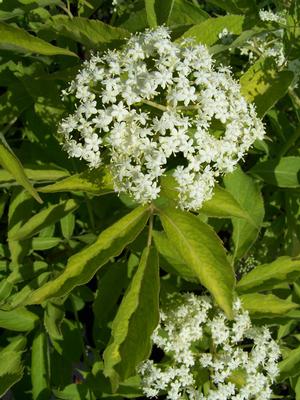
1. Sambucus canadensis 'Aurea' develops the same great clusters of fruit beloved by Blue Birds, wine makers and lovers of homemade preserves.
Part II: Bluebird Habitat and Feeding
Most of us simply erect a feeder filled with a seed mix then wait and watch as to which birds may show up to feed. This can be a barometer indicating which seed-eaters are local inhabitants. This cannot paint a complete picture as numerous species are not partial to this ploy. It is important to look beyond our feeders observing birds at the edges of our habitats. Knowing your landscape and surrounding terrains, noting which species frequent your property will help you make smart plant choices which can aid your local bird population. The observant can then tailor foods to attract species both to our decks and landscapes. Woody plants will not only provide nourishment but equally important cover and nesting opportunities, too.
For instance, if you live adjacent to fields, pasture and open woodlands these habitats are more likely to harbor Bluebirds. Beloved and keen-eyed Bluebirds are rapacious insectivores consuming spiders, caterpillars, ants and beetles. But being consummate omnivores they also eat the fruits of Elderberry (see pic 1), Flowering Dogwood, Virginia creeper and Serviceberry (Amelanchier). I have watched these beautiful creatures eagerly ingest berries from evergreen hollies (see pic 2) and Red Cedars in snow-covered landscapes in mid-winter when insects are few. You can supplement their preferred foods when harsher seasons prevail by planting in your landscape evergreen hollies and Red Cedars which hold onto their fruit in winter. When times are tough Bluebirds will naturally default to these plants. And during a warm winter day they might even find an insect treat among the branches.
Serviceberries flower in the middle of spring. Their delicious fruits ripen quickly becoming available in late spring and early summer. Elderberries form copious summer fruits and prefer moist soils forming thickets which also provide cover. The fruit of Flowering Dogwood (Cornus florida), one of our loveliest native trees, ripens late summer and is available food during fall migration.
You can build feeding stations. Bluebirds (and numerous other species, too) will flock to your feeders when baiting them with the following recipe: mix together 1 teaspoon corn oil, 2 cups all-purpose flour, 3 cups yellow corn meal, 1 cup of peanut butter (unsalted) to 1 pound melted lard. Optional: you may add raisins, sunflower hearts, raw peanuts and/or meal worms (available from most pet stores and some aquariums). Form into a roll. Refrigerate. When cool cut into pieces to fit small suet feeders, tie up with raffia to hang from nearby branches or set in shallow bowls atop squirrel-proof poles.
Erecting a Bluebird house at the edge of your field will provide a nesting opportunity. It was long thought that a two-inch diameter entrance in the front wall was optimum however a one and one-half inch hole will suffice. Place the house five or so feet above the ground mounted on a post. It is important to keep an eye out for English House Sparrows and English Starlings which are aggressive competitors. These foreign invaders will steal a nest right out from under the inhabitants. Both exotic species have been an impediment to Bluebirds reclaiming their former territories. Our native Cowbirds are no kinder. They will commandeer a nest while the Bluebirds are searching for food, crush the inhabitant’s eggs, lay their own and trick the unsuspecting parents into raising a generation of Cowbirds. Reprobates! Bluebirds are, nevertheless making modest strides. You can help them along by being vigilant when they are nesting, rooting-out would be marauders, providing cover and making or planting foods which enhance their wild forage.
Numerous birds are omnivorous feasting upon both insect and seed. Robins tirelessly peruse patches of lawn for night crawlers but will strip bare in late summer during migration the weeping fruit-laden branches from sour Black Chokeberry (Aronia melanocarpa - see pic 3). They nest in trees and conifers alike (see pic 4). They will also set-up housekeeping on a platform under an eave. Red-bellied Woodpeckers, increasing their northerly range have become a common sight in southern New England. They are drawn to many of the same fruits to which Bluebirds are fond plus starchy acorns and beech nuts as well. They will also grab a seed snack from a feeder. Like most woodpeckers they are beneficial to farmers and gardeners as they gobble grasshoppers, wood-boring beetles and various pests. They usually nest in still vertical expired trees in which they’ve carved a pocket to keep their little ones warm and dry. If a dead tree on you’re the fringes of your property doesn’t endanger buildings or neighbors consider allowing it to stand so as to help the woodpeckers.
An excellent text in which you may refer to both habitat and identification of unfamiliar species is the Field Guide to Birds, Eastern Region by the National Audubon Society, published by Alfred A. Knopf, New York. You can find it online at www.randomhouse.com/audubon. Stay tuned.

